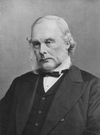Surgery in the 19th Century Flashcards
What were the 3 main problems in surgery in the 1800s?
1) Pain.
2) Blood loss.
3) Infection.
Who was Robert Liston?
A famous surgeon in the 19th century.
Known for being very fast, although to this day the only surgeon with an operation with 300% mortality rate.
When was nitrous oxide discovered?
Laughing gas was discovered to reduce the sensation of pain by Sir Humphrey Davy in 1799.
Used in 1844 by Horace Wells in a dental procedure.
When was cocaine discovered as a local anaesthetic?
Karl Koller used cocaine in an eye operation in 1884.
How did anaesthetic dosage become easier to control?
In the 1930s Helmut Wesse developed anaesthetic which could be injected.
When was ether discovered?
Warren and Morton demonstrated its properties of ether whilst removing a neck tumour in 1846.
Who discovered the anaesthetic qualities of chloroform and when?
James Simpson in 1847, by chance.

Why was there opposition to chloroform?
- Overdoses caused deaths (e.g: Miss Greener 1848).
- Side effects were not yet known.
- Religion➡️Beliefs pain of childbirth came from God and so women should endure it.
- Less urgency meant surgeons were more adventurous➡️More blood loss and death.
Why did chloroform become part of standard practice?
- 1847 Simpson compared himself to Pare.
- 1857 Queen Victoria used chloroform giving birth to her eighth child.
- John Snow developed an inhaler which made overdosing less likely.
What were the advantages and disadvantages to nitrous oxide?
✅Gas dulled the sensation of pain felt by patients.
✅Proved suitable for use in dentistry and enabled dentists to carry out procedure effectively.
❌Difficult to regulate dosage as it was a gas.
❌Horace Well’s first public demonstration was only partially successful.
❌Gas could seep into operating theatre and affect surgeon.
❌Nitrous oxide not strong enough for use in major surgery.
What were the advantages and disadvantages to ether?
✅Cause the patient to fall asleep and gave surgeon oppurtunity to carry out operation.
✅Ether used effectively whilst Robert Liston carried out leg amputation in 1847.
❌Some surgeons didn’t like it because of its pungent smell.
❌Unstable chemical that produced a flammable vapour.
❌Irritated the lungs of patients causing coughing.
❌Cause patients to feel nauseous and often patients could be sick.
What problems in surgery caused infection?
❌Doctors re-using bandages.
❌Doctors didn’t wash their hands.
❌Equipment not sterilised.
Who was Ignaz Semmelweiss?

A Hungarian doctor working in Austria, concerned by the deaths of apparently healthy women after childbirth.
What was Semmelweiss’ observations and how did he explain them?
He observed women whose babies were delivered by midwives were less likely to die from infection than women who were delivered by medical students.
He believed the reason was that medical students came straight to delivery rooms after dissecting dead bodies➡️If they washed their hands it would reduce the risk of infection to women.
Why was Semmelweiss not believed?
He tried to get doctors to wash their hands, calling those who didn’t ‘murderers’ but at the time was regarded as a crank and fanatic and even mentally unstable.
Who was Joseph Lister?

One of the most outstanding surgeons of the 19th century.
His father was the pioneer of the improved microscope, researched gangrene and infection and read the work of Pasteur on Germ Theory.
What did Lister discover?
He had seen carbolic spray used to treat sewage, he experimented with it and found that a thin mist of carbolic acid sprayed over a wound during surgery limited infection.
By following this with careful bandaging the wound would heal and not develop gangrene.
How did hand washing with carbolic acid before operations improve surgery?
Sterile hands reduced the risk of passing infections.
How did using carbolic spray in operating theatres improve surgery?
Sterilised the air around the operating theatre, reducing the risk of airborne bacteria.
How did antiseptic ligatures improve surgery?
Bloodloss could now be prevented without risking infection.
What opposition was there to Lister’s carbolic spray?
❌It cracked the surgeon’s skin and made everything smell. It caused extra work and made operations more expensive and less pleasant for surgeons.
❌Speed was essential in an operation➡️Lister’s antiseptic methods slowed operations down.
❌When some surgeons tried copying Lister’s methods they did not get the same result➡️His critics said it did not work.
❌Many surgeons did not like him, regarding him as cold, arrogant and a fanatic. When he said he achieved good results, other surgeons felt he was criticising them.
What happened in:
1887?
1894?
1896?
1887➡️All instruments steam-sterilised.
1894➡️Sterilised rubber gloves.
1896➡️First heart operation.
Who discovered X-rays?
Wilhelm Rontgen in 1885.
The German scientist was experimenting with cathode rays, which he discovered could pass through wood, rubber, human flesh but not bone and metal.
How did X-rays improve medicine?
Within 6 months they were being used in hospitals, but the outbreak of WW1 really confirmed their importance. X-rays improved the success rate of surgery in removing deeply lodged bullets.


